Nakahara M. Geometry, Topology and Physics
Подождите немного. Документ загружается.

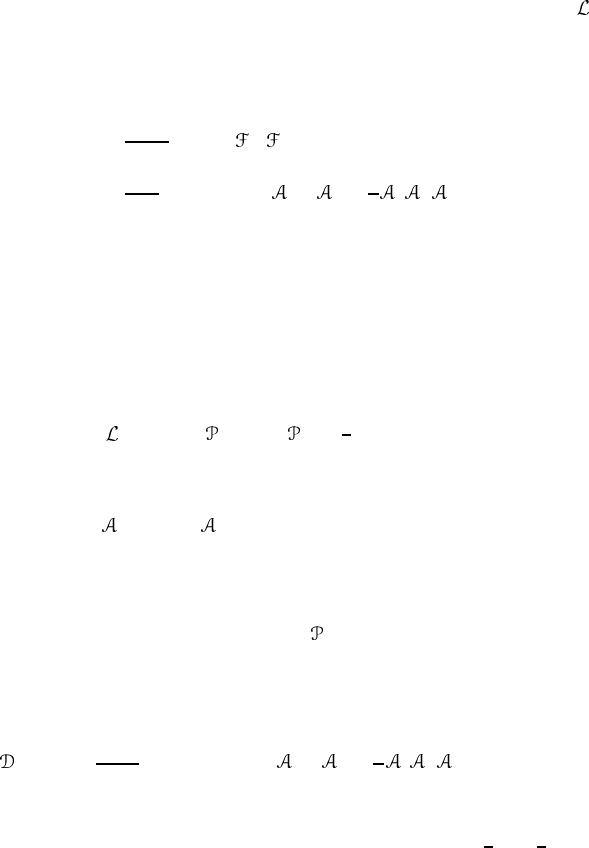
called the chiral symmetry. The chiral current j
5
derived from this symmetry is
j
µ
5
≡
¯
ψγ
µ
γ
5
ψ. (13.4)
In general, whether the symmetry of a Lagrangian is retained under quantization
is not a trivial question. In fact, it has been shown that the chiral symmetry of
is destroyed at the quantum level. Adler (1969) and Bell and Jackiw (1969) have
shown by computing the triangle diagram with an external axial current and two
external vector currents that the naive conservation law ∂
µ
j
µ
5
= 0 is violated,
∂
µ
j
µ
5
=
1
16π
2
κλµν
tr
κλ µν
=
1
4π
2
tr
κλµν
∂
κ
λ
∂
µ ν
+
2
3
λ µ ν
(13.5)
where tr is a trace over the group indices. The current j
µ
5
which appears in (13.5)
has no group index, and, hence, (13.5) is called the Abelian anomaly.
It is interesting to study the behaviour of a current which carries the group
index. Consider a Weyl fermion ψ which couples with an external gauge
field. The non-Abelian gauge current of the theory also satisfies an anomalous
conservation law which defines the non-Abelian anomaly. The action is given
by
≡ ψ
†
(i
/
∇)
+
ψ
±
=
1
2
(I ± γ
5
). (13.6)
The Lagrangian has the gauge symmetry
µ
→ g
−1
(
µ
+ ∂
µ
)g ψ → g
−1
ψ. (13.7)
The corresponding non-Abelian current is
j
µα
≡ ψ
†
γ
µ
T
α
+
ψ. (13.8)
It has been shown by Bardeen (1969) and Gross and Jackiw (1972) that, up to the
one-loop level, the current is not conserved,
(
µ
j
µ
δ
)
α
=
1
24π
2
tr
T
α
∂
κ
κλµν
λ
∂
µ ν
+
1
2
λ µ ν
. (13.9)
At first sight, the RHSs of (13.5) and (13.9) look very similar. However, the
difference between the normalization and the numerical factors of
2
3
and
1
2
have
a deep topological origin. We shall see later that the Abelian anomaly in (2l + 2)
dimensions and the non-Abelian anomaly in 2l dimensions are closely related but
in an unexpected manner.
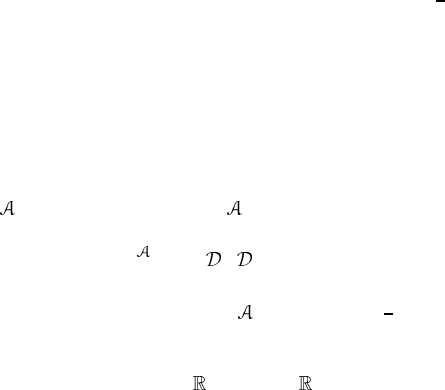
13.2 Abelian anomalies
Henceforth, we work in an even-dimensional manifold M (dim M = m = 2l)
with a Euclidean signature. Four-dimensional results will readily be obtained by
putting m = 4. We assume our system is non-chiral, namely, the gauge field
couples to the right and the left components in the same way. Our convention is
γ
µ†
= γ
µ
{γ
µ
,γ
ν
}=2δ
µν
γ
m+1
= (i)
l
γ
1
...γ
m
γ
m+1†
= γ
m+1
(γ
m+1
)
2
=+I.
The Lie group generators {T
α
} satisfy
T
†
α
=−T
α
[T
α
, T
β
]= f
αβ
γ
T
γ
tr(T
α
T
β
) =−
1
2
δ
αβ
.
13.2.1 Fujikawa’s method
Among several methods of deriving anomalies, Fujikawa’s way (Fujikawa 1979,
1980, 1986) reveals the topological and geometrical nature of the problem most
directly. This method is equivalent to the heat kernel proof of the relevant index
theorem.
Let ψ be a massless Dirac field interacting with an external non-Abelian
gauge field
µ
. The effective action W [ ] is given by
e
−W [ ]
=
ψ
¯
ψ e
−
dx
¯
ψi
/
∇ψ
(13.10)
where i
/
∇=iγ
µ
∇
µ
= iγ
µ
(∂
µ
+ ω
µ
+
µ
), with ω
µ
=
1
2
ω
µαβ
αβ
being the
spin connection of the background space. We compactify the space in such a
way that the geometry (the spin connection) plays no role. For example, this
can be achieved by compactifying
4
to S
4
=
4
∪{∞}, for which the Dirac
genus
ˆ
A(TM) is trivial; see example 12.5. If this is the case, the spin connection
is irrelevant and may be dropped from i
/
∇. The classical action
dx
¯
ψi
/
∇ψ is
invariant with respect to the chiral rotation,
ψ → e
iγ
m+1
α
ψ
¯
ψ →
¯
ψe
iγ
m+1
α
. (13.11)
We expand ψ and
¯
ψ as
ψ =
i
a
i
ψ
i
¯
ψ =
i
¯
b
i
ψ
†
i
(13.12)
where a
i
and
¯
b
i
are anti-commuting Grassmann variables,
{a
i
, a
j
}=0 {
¯
b
i
,
¯
b
j
}=0 {a
i
,
¯
b
j
}=0
and ψ
i
is an eigenvector of the Dirac operator
i
/
∇ψ
i
= λ
i
ψ
i
. (13.13)

Since i
/
∇ is Hermitian, λ
i
is real. Since M is compact, ψ
i
can be normalized as
ψ
i
|ψ
j
=
dxψ
†
i
(x )ψ
j
(x ) = δ
ij
.
Now the path integrals over ψ and
¯
ψ are replaced by those over a
i
and
¯
b
i
.
Consider an infinitesimal chiral transformation,
ψ(x) → ψ(x) + iα(x)γ
m+1
ψ(x) (13.14a)
¯
ψ(x ) →
¯
ψ(x ) + i
¯
ψ(x )α(x)γ
m+1
. (13.14b)
As usual, we take α = α(x) to be x-dependent. Under this change, the classical
action transforms as
dx
¯
ψi
/
∇ψ →
dx (
¯
ψ + i
¯
ψαγ
m+1
)i
/
∇(ψ + iαγ
m+1
ψ)
=
dx
¯
ψi
/
∇ψ + i
dx [α
¯
ψγ
m+1
i
/
∇ψ +
¯
ψi
/
∇(αγ
m+1
ψ)]
=
dx
¯
ψi
/
∇ψ −
dx [α
¯
ψγ
m+1
γ
µ
(∂
µ
+
µ
)ψ
+
¯
ψγ
µ
(∂
µ
+
µ
)(αγ
m+1
ψ)]
=
dx
¯
ψi
/
∇ψ +
dx α(x)∂
µ
j
µ
m+1
(x ) (13.15)
where we have used the anti-commutation relations {γ
µ
,γ
m+1
}=0and
j
µ
m+1
(x ) ≡
¯
ψ(x)γ
µ
γ
m+1
ψ(x) (13.16)
is the chiral current. This is the higher-dimensional analogue of j
µ
5
defined
previously. If (13.15) were the only change caused by (13.14), naive application
of the Ward–Takahashi relation would imply the conservation of the axial current
∂
µ
j
µ
m+1
= 0. In quantum theory, however, we have an additional change, namely
the change of the path integral measure. Define the chiral-rotated fields by
ψ
= ψ + iαγ
m+1
ψ =
a
i
ψ
i
(13.17a)
¯
ψ
=
¯
ψ + i
¯
ψαγ
m+1
=
¯
b
i
ψ
†
i
. (13.17b)
Now the measure changes as
i
da
i
d
¯
b
i
→
i
da
i
d
¯
b
i
. (13.18)
From the orthonormality of {ψ
i
},wefindthat
a
i
=ψ
i
|ψ
=ψ
i
|(1 +iαγ
m+1
)ψ
=
j
ψ
i
|(1 + iαγ
m+1
)ψ
j
a
j
≡
j
C
ij
a
j
(13.19a)

where
C
ij
=ψ
i
|(1 +iαγ
m+1
)ψ
j
=δ
ij
+ iαψ
i
|γ
m+1
ψ
j
. (13.20)
The measure in terms of the new variables is
da
j
=[det C
ij
]
−1
da
i
= exp(−tr ln C
ij
)
da
i
= exp[−tr ln(I + iαψ
i
|γ
m+1
ψ
j
)]
da
i
≈ exp(−tr iαψ
i
|γ
m+1
ψ
j
)
da
i
= exp
− iα
i
ψ
i
|γ
m+1
ψ
i
da
i
(13.21)
where the inverse of the determinant appears since a
i
and a
i
are Grassmann
variables, see Berezin (1966).
1
As for
¯
b
i
→
¯
b
i
,wehave
¯
b
i
=
j
¯
b
j
ψ
j
|(1 +iαγ
m+1
)|ψ
i
=
j
C
ji
¯
b
j
.(13.19b)
The Jacobian for the change
¯
b
i
→
¯
b
i
agrees with (13.21). Thus, the measure
transforms under the chiral rotation (13.17) as
i
da
i
d
¯
b
i
→
i
da
i
d
¯
b
i
exp
− 2i
dx α(x)
ψ
†
n
(x )γ
m+1
ψ
n
(x )
.
(13.22)
Now the effective action has two expressions:
e
−W [ ]
=
i
da
i
d
¯
b
i
exp
−
dx
¯
ψi
/
∇ψ
=
i
da
i
d
¯
b
i
exp
−
dx
¯
ψi
/
∇ψ −
dx α(x)∂
µ
j
µ
m+1
(x )
− 2i
dx α(x) A(x)
(13.23)
where
A(x) ≡
i
ψ
†
i
(x )γ
m+1
ψ
i
(x ). (13.24)
Since α(x) is arbitrary, we have
∂
µ
j
µ
m+1
(x ) =−2i A(x ). (13.25)
1
See section 1.5. For example, we have
a da =
ca d(ca) = 1, c ∈ and a being a real
Grassmann number. This shows that d(ca) = da/c.
Thus, naive conservation of an axial current does not hold in quantum theory.
This non-conservation of the current j
µ
m+1
is called the Abelian anomaly (or
chiral anomaly or axial anomaly).
How is this related to the topology? Let us look at the Jacobian (13.22)
and assume that α(x) is independent of x.
2
The integral in (13.22) is not well
defined and must be regularized. We introduce the Gaussian cut-off (heat kernel
regularization) as
dx A(x) =
dx
i
ψ
†
i
(x )γ
m+1
ψ
i
(x ) exp[−(λ
i
/M)
2
]|
M→∞
=
ψ
i
|γ
m+1
exp[−(i
/
∇/M)
2
]|ψ
i
|
M→∞
. (13.26)
In (13.26), 1/M
2
corresponds to the ‘time’ parameter t in the previous chapter
and M →∞implies t → ε.Let|ψ
i
be an eigenstate of i
/
∇ with non-vanishing
eigenvalue λ
i
. Among the eigenstates, there exists a state |ψ
i
χ
≡ γ
m+1
|ψ with
eigenvalue −λ
i
:
i
/
∇|ψ
i
χ
= i
/
∇γ
m+1
|ψ
i
=−γ
m+1
i
/
∇|ψ
i
=−λ
i
γ
m+1
|ψ
i
=−λ
i
|ψ
i
χ
where use has been made of the anti-commutation relation {γ
m+1
, i
/
∇}= 0. Since
i
/
∇ is a Hermitian operator, eigenvectors which belong to different eigenvalues are
orthogonal, hence ψ
i
|ψ
i
χ
=ψ
i
|γ
m+1
|ψ
i
=0. This shows that
ψ
i
|γ
m+1
exp[−(i
/
∇/M)
2
]|ψ
i
=ψ
i
|γ
m+1
|ψ
i
exp[−(λ
i
/M)
2
]=0.
Thus, the contribution to the RHS of (13.26) comes only from the zero-energy
modes. Let |0, i be the zero-energy modes of i
/
∇, (1 ≤ i ≤ n
0
).Theyare
not in an irreducible representation of the spin algebra and should be classified
according to the eigenvalue of γ
m+1
. We write
γ
m+1
|0, i
±
=±|0, i
±
. (13.27)
Then, (13.26) becomes
dx A(x) =
ψ
i
|γ
m+1
exp[−(i
/
∇/M)
2
]|ψ
i
|
M→∞
=
+
i
0, i |0, i
+
−
−
i
0, i |0, i
−
= ν
+
− ν
−
= ind i
/
∇
+
(13.28)
where ν
+
(ν
−
) is the number of zero-energy modes with positive (negative)
chirality (ν
+
+ ν
−
= n
0
)andi
/
∇
+
is defined by
i
/
∇=
0i
/
∇
−
i
/
∇
+
0
i
/
∇
−
= (i
/
∇
+
)
†
.
2
We are looking at the zero-momentum Ward–Takahashi relation.
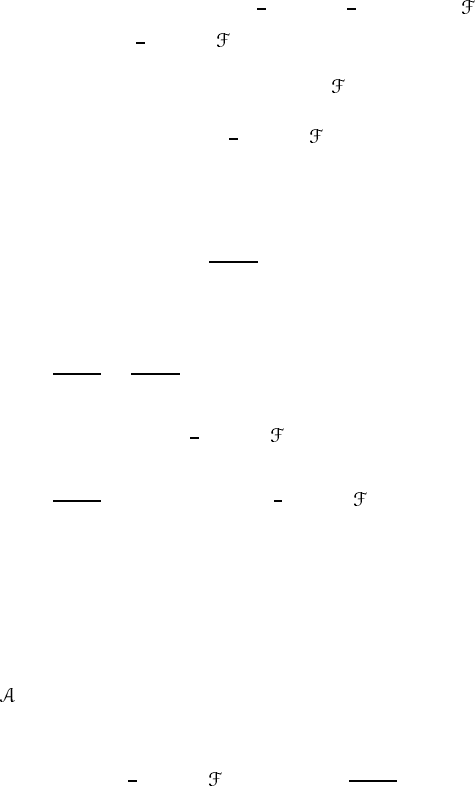
The Atiyah–Singer index theorem now comes into the problem.
To show that (13.28), indeed, represents an integral of the relevant Chern
character, we first note that
(i
/
∇)
2
=−γ
µ
γ
ν
∇
µ
∇
ν
=−{δ
µν
+
1
2
[γ
µ
,γ
ν
]}
1
2
[{∇
µ
, ∇
ν
}+
µν
]
=−∇
µ
∇
µ
−
1
4
[γ
µ
,γ
ν
]
µν
(13.29)
where use has been made of the relation [∇
µ
, ∇
ν
]=
µν
.Then
A(x) =
i
ψ
i
|xx|γ
m+1
exp[(∇
2
+
1
4
[γ
µ
,γ
ν
]
µν
)/M
2
]|ψ
i
|
M→∞
. (13.30)
Let us take m = 4 for definiteness. We introduce the plane wave basis as
x |ψ
i
=
d
4
k
(2π)
4
x |kk|ψ
i
.
Then (13.30) becomes
A(x) =
dk
(2π)
4
dk
(2π)
4
i
ψ
i
|k
k
|x
× γ
m+1
exp[(∇
2
+
1
4
[γ
µ
,γ
ν
]
µν
)/M
2
]x |kk|ψ
i
M→∞
y→x
=
dk
(2π)
4
tr γ
m+1
exp[(−k
2
+
1
4
[γ
µ
,γ
ν
]
µν
)/M
2
]
M→∞
(13.31)
where use has been made of the completeness property
i
k|ψ
i
ψ
i
|k
=(2π)
4
δ
4
(k − k
).
In (13.31), we have replaced ∇
2
by the symbol −k
2
since the residual terms
containing
do not survive in the limit M →∞. If we put
˜
k
µ
≡ k
µ
/M,
(13.31) becomes
A(x) = tr[γ
5
exp(
1
4
[γ
µ
,γ
ν
]
µν
/M
2
)]M
4
d
˜
k
(2π)
4
exp(−
˜
k
2
).
We expand the first exponential and use
tr γ
5
= tr γ
5
γ
µ
γ
ν
= 0trγ
5
γ
κ
γ
λ
γ
µ
γ
ν
=−4
κλµν
d
˜
k exp(−
˜
k
2
) = π
2
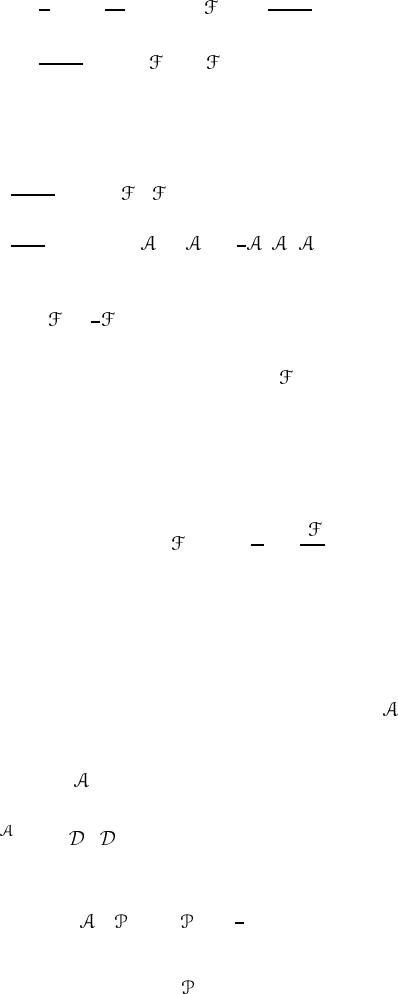
to obtain
A(x) =
1
2
tr
γ
5
1
4
2
{[γ
µ
,γ
ν
]
µν
}
2
1
16π
2
=
−1
32π
2
tr
κλµν
κλ
(x )
µν
(x ). (13.32)
Note that the higher-order terms in the expansion of the exponential vanish in the
limit M →∞. The anomalous conservation law (13.25) now becomes
∂
µ
j
µ
5
=
1
16π
2
tr
κλµν
κλ µν
=
1
4π
2
tr[
κλµν
∂
κ
(
λ
∂
µ ν
+
2
3
λ µ ν
)]. (13.33)
This is regarded as a local version of the AS index theorem. Let us write (13.33)
in terms of the field strength
=
1
2
µν
dx
µ
∧ dx
ν
. We easily verify that
ν
+
− ν
−
=
M
dx ∂
µ
j
µ
m+1
=
M
ch
2
( ). (13.34)
This is the index theorem for a twisted spinor complex with trivial background
geometry (
ˆ
A(TM) = 1).
For dim M = m = 2l, we have the following identity:
ν
+
− ν
−
=
M
dx ∂
µ
j
µ
m+1
=
M
ch
l
( ) =
M
1
l!
tr
i
2π
l
. (13.35)
13.3 Non-Abelian anomalies
In the last section we considered the chiral current which is a gauge singlet (no
gauge indices). Now we turn to the study of the gauge current j
µ
α
where α is the
gauge index. Here we consider a chiral theory in which the gauge field
couples
only to the left-handed Weyl fermion ψ. Suppose ψ transforms in a complex
representation r of the gauge group G. For example, suppose ψ belongs to a 3 of
SU(3). The effective action W
r
[ ] is given by
e
−W
r
[ ]
=
ψ
¯
ψ exp
−
dx
¯
ψi
/
∇
+
ψ
(13.36)
where
i
/
∇
+
= iγ
µ
(∂
µ
+
µ
)
+ ±
=
1
2
(1 ± γ
m+1
). (13.37)
The gauge current is
j
µ
α
= i
¯
ψγ
µ
T
α +
ψ. (13.38)
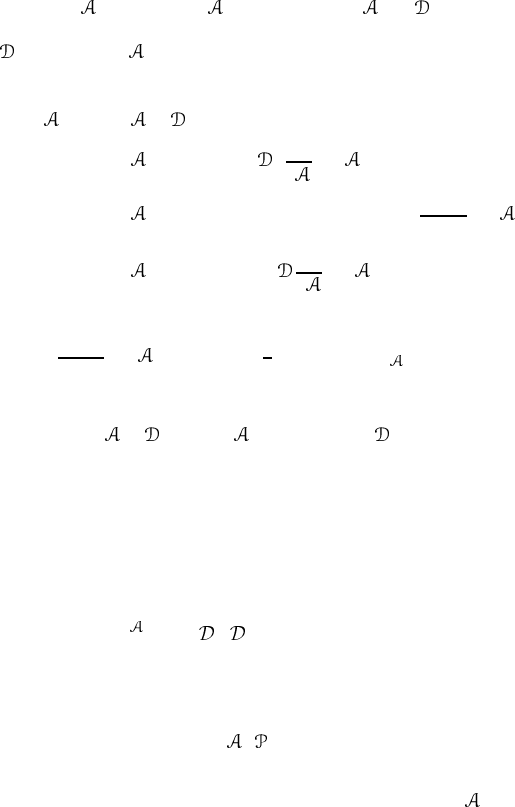
Let v = v
α
T
α
be an infinitesimal gauge transformation parameter, g = 1 − v
under which we have
µ
→ (1 + v)(
µ
+ d)(1 −v) =
µ
−
µ
v (13.39)
where
µ
v ≡ ∂
µ
v +[
µ
,v] is the covariant derivative for a field in the adjoint
representation. The effective action transforms as
W
r
[ ]→W
r
[ − v]
= W
r
[ ]−
dx tr
v
δ
δ
W
r
[ ]
= W
r
[ ]−
dx tr(∂
µ
v
α
+ f
αβγ
A
µ
β
v
γ
)
δ
δ A
µ
α
W
r
[ ]
= W
r
[ ]+
dx tr
v
α
δ
δ
W
r
[ ]
α
. (13.40)
Since
δ
δ A
µ
α
W
r
[ ]=i
¯
ψγ
µ
T
α
1
2
(1 + γ
m+1
)ψ =j
µ
α
we obtain
W
r
[ − v]−W
r
[ ]=
dx tr(v
α
µ
j
µ
α
). (13.41)
We are naively tempted to regard (13.36) as det(i
/
∇) =
λ
i
, λ
i
being the
‘eigenvalue’ of i
/
∇. A subtlety arises here: i
/
∇
+
maps sections of S
+
⊗ E to those
of S
−
⊗ E,whereE is the vector bundle associated with the G bundle and S
±
are spin bundles with chirality ±. Accordingly, the equation i
/
∇
+
ψ = λψ is
meaningless. To avoid this difficulty, we formally introduce a Dirac spinor ψ and
define
e
−W
r
[ ]
=
ψ
¯
ψ exp
−
dx
¯
ψi
ˆ
Dψ
(13.42)
where i
ˆ
D is defined by
i
ˆ
D ≡ iγ
µ
(∂
µ
+ i
µ +
) =
0i
/
∂
−
i
/
∇
+
0
(13.43)
where we have diagonalized γ
m+1
. In (13.43), the gauge field couples only
to the positive chirality field. Now the eigenvalue problem i
ˆ
Dψ
i
= λ
i
ψ
i
is well
defined. Note that i
ˆ
D is not Hermitian and λ
i
is a complex number in general.
Moreover, we need to introduce right and left eigenfunctions separately by
i
ˆ
Dψ
i
= λ
i
ψ
i
(13.44a)
χ
†
i
(i
←
ˆ
D) = λ
i
χ
†
i
(i
ˆ
D)
†
χ
i
=
¯
λ
i
χ
i
. (13.44b)
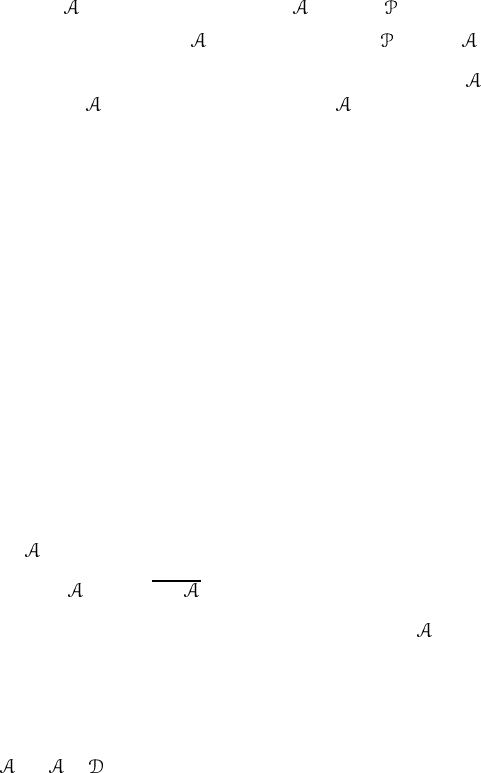
Since
χ
†
i
ψ
j
dx = 0fori = j , we may choose an orthonormal basis,
χ
†
i
ψ
j
dx = δ
ij
. (13.45)
It should be noted that the eigenvalue λ
i
is not gauge invariant. This follows from
the observation that
g(i
ˆ
D(
g
))g
−1
= giγ
µ
[∂
µ
+ g
−1
(
µ
+ ∂
µ
)g
+
]g
−1
= i
ˆ
D( ) − i
/
∂gg
−1
+ i
/
∂gg
−1
+
= i
ˆ
D( ). (13.46)
If the equality were to hold in (13.46), g
−1
ψ
i
would satisfy i
ˆ
D(
g
)g
−1
ψ
i
=
λ
i
g
−1
ψ
i
when i
ˆ
D( )ψ
i
= λ
i
ψ
i
. Then Spec i
ˆ
D( ) would be gauge invariant.
Although individual eigenvalues are not gauge invariant, the absolute value of the
product of eigenvalues of i
ˆ
D is gauge invariant. In fact,
det(i
ˆ
D) det((i
ˆ
D)
†
) = det(i
ˆ
D(i
ˆ
D)
†
)
= det
(i
/
∂
−
)(i
/
∂
+
) 0
0 (i
/
∇
+
)(i
/
∇
−
)
= det(i
/
∂
−
i
/
∂
+
) det(i
/
∇
+
i
/
∇
−
) (13.47)
where i
/
∂
+
= (i
/
∂
−
)
†
and i
/
∇
−
= (i
/
∇
+
)
†
. This is simply the Dirac determinant
(up to an irrelevant factor det(i
/
∂
−
i
/
∂
+
)),
[det(i
/
∇)]
2
= det
i
/
∇
−
i
/
∇
+
0
0i
/
∇
+
i
/
∇
−
=[det(i
/
∇
+
i
/
∇
−
)]
2
(13.48)
where i
/
∇ is given by
i
/
∇=
0i
/
∇
−
i
/
∇
+
0
. (13.49)
The Dirac determinant is gauge invariant, hence so is |det(i
ˆ
D)|. It then follows
that Re W
r
[ ] is gauge invariant since
exp(−W
r
[ ]) exp(−W
r
[ ]) = det(i
ˆ
D) det((i
ˆ
D)
†
) ∝ det(i
/
∇
+
i
/
∇
−
)
is gauge invariant. Therefore, only the imaginary part of W
r
[ ], that is the phase
of det(i
ˆ
D), may gain an anomalous variation under gauge transformations.
The anomaly may be computed by evaluating the Jacobian as before. The
functional measure is taken to be
i
da
i
d
¯
b
i
. We consider an infinitesimal gauge
transformation,
→ − vψ→ ψ + vψ
+
¯
ψ →
¯
ψ −
¯
ψ
−
v (13.50)
where the gauge transformation rotates the positive chirality parts only. The
Jacobian factor is
dx tr v(x)
n
(n|x γ
m+1
x |n (13.51)

where x |n=ψ
n
(x ) and (n|x =χ
†
n
(x ) (note that (n| is not the Hermitian
conjugate of |n). This integral is ill defined and must be regularized. As before,
we employ the Gaussian regulator,
dx lim
M→∞
x→y
tr v(x)
n
(n|yγ
m+1
x |e
−(i
ˆ
D)
2
/M
2
|n
=
dx lim
M→∞
x→y
tr v(x)γ
m+1
e
−(i
ˆ
D
x
)
2
/M
2
δ(x − y) (13.52)
where use has been made of the completeness relation
n
|n(n|=I. (13.53)
It follows from (13.41) and (13.52) that
dx v
α
µ
δ
δ A
µ
α
W
r
[ ]
=
dx lim
M→∞
x→y
tr[vγ
m+1
e
−(i
ˆ
D
x
)
2
/M
2
δ(x − y)].
(13.54)
In the present case W
r
really changes under (13.50). The trace may be written as
tr[vγ
m+1
e
−(i
ˆ
D
x
)
2
/M
2
]=tr[v(
+
−
−
)e
−(i∂
−
i∇
+
)−(i∇
−
i∂
+
)/M
2
]
= tr[v P
+
e
(i∂i∇)/M
2
]−tr[v P
−
e
(i∇i∂)/M
2
]. (13.55)
(13.55) can be evaluated in the plane wave basis, which is straightforward but
tedious (see Gross and Jackiw (1972), for example). We derive the non-Abelian
anomaly from a topological viewpoint in the next section. For m = 4, the
anomalous variation is
W
r
[ − v]−W
r
[ ]=
dx v
α
µ
j
µ
α
=
1
24π
2
dx tr{v
α
T
α
κλµν
∂
κ
[
λ
∂
µ ν
+
1
2
λ µ ν
]}
=
1
24π
2
tr{vd[
d +
1
2
3
]}. (13.56)
The anomalous divergence of the gauge current is
µ
j
µ
α
=
1
24π
2
tr{T
α
κλµν
∂
κ
[
λ
∂
µ ν
+
1
2
λ µ ν
]}. (13.57)
This should be compared with (13.33). There are two differences between these
results: the two-thirds in front of
3
is replaced by a half and the overall factor is
different.
